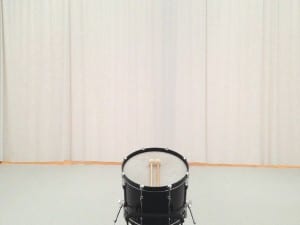Jaakko Mattila – Artist from Rami Lappalainen on Vimeo.
On show until 17 December at the James Hockey & Foyer Galleries, part of the University for the Creative Arts in Farnham, is international artist Jaakko Mattila with his new exhibition Lowest Common Denominator.
Now based in Oulu, Finland, Jaakko returns to UCA, where he graduated in 2001, with an impressive collection of oil, gloss, watercolour and print.
Christine Kapteijn, UCA Galleries Curator and Manager spoke to Jaakko before the exhibition:
CK: How do you choose the medium for a particular work? How does that develop?
JM: Most of the ideas come from the media themselves; it’s a natural process, they choose themselves. The media have these qualities I like about them, their own physicality. Somehow, with the images or paintings I try to make, the medium tells me where to go. I just think about what it is possible to do with one medium, what kind of image would best be done with that sort of medium. For example, in watercolours I can make some shades pretty close to white, in ten layers and with amazing qualities from the paper and the pigment. But then again, with oils you can achieve so many other effects. They are pictures, so it’s all about the surface and how it feels. Nowadays I don’t really plan as much as you might think. For example, this piece here I have in the background, the main piece, I didn’t really know what I was going to do – I just stretched the paper and then I started painting (One as shown in the video). So it’s different for each piece of work.
CK: Does the medium also indicate to you the scale of the work?
JM: Yes, actually, because of their physical properties. You can’t drip watercolours for more than two metres, for example, because of the properties of water. With gloss, there’s a physical limit to paintings too. I can’t make any paintings larger than three metres squared because I can’t really size them properly. I have never been given the scale for exhibiting these larger works either. The show at the James Hockey & Foyer Galleries is the first time I can exhibit the gloss pieces. I always wanted to show three of these landscapes together, because I use three different backgrounds: white, black and grey. They are very large so it is the first time I can present the complete series together. That in itself is going to be quite strong. I am looking forward to it.
CK: You say your pictures are about the surface?
JM: Well, all pictures are about the surface.
CK: Yes, but your pictures go further than that. They are very much about what is behind the surface, it seems?
JM: Yes, definitely. I try to eliminate the surface, that’s the thing really. That’s critical for me. And when I look at paintings too, I like pictures that somehow don’t make me think about the surface at all. If the painting is good you’ll easily get behind it.
CK: How do you plan and execute such works?
JM: I research colours in depth. It’s like chemistry: I buy the pigments not the names of the colours or anything like that. I have a list of all the pigments in the world; I know all the chemical formulae. But it’s still pretty basic. Each pigment and each colour have totally different qualities. You can clearly see in the watercolours and in all the paints that certain areas of colour are really difficult to make; you have to work at a mixture. Colour and tone are these elements that we separate visually. And that’s why I use all these colours.
I like to question things all the time too and think about what you can do and how to present it. Otherwise it would be kind of boring. For example, in my next solo show at the Oulu Museum of Art in 2012, I will be creating a mural in watercolour technique, directly onto the wall. It’s going to be interesting, I think it will work.
CK: Don’t you ever repeat yourself?
JM: I sometimes do the same thing because I’m quite critical. If I haven’t executed some visual idea as well as I should have, in my view, I might do it again or I will try it on a different scale. There are certain elements like this circle or like these spirals that repeat themselves in my work because I really like those forms.
CK: What I find strange is that your work looks really planned and considered but at the same time utterly direct and in the moment.
JM: Yeah, for this circle here there was no preliminary drawing or plan. It’s not even a real circle; it’s a little bit wonky. I repair it and fix it a little as I go along.
CK: Right, so are you on a continuous feedback loop: adjusting all the time?
JM: Yes, like these big gloss works, which take a few hours a day for one piece and are absolutely huge. You wouldn’t think that. It’s a very different process all the time.
CK: How do your prints relate to your original works; do you find they provide a release, a different distance to the process?
JM: Yes, prints are strange because they are the only works that involve a lot of planning because of the process: it is really slow. The copper prints are especially slow, involving a lot of chemicals and a lot of different phases within one work.
CK: When you refer to ‘global visually interesting art’ in your statement what do you mean?
JM: Well that’s the central point: Lowest Common Denominator refers to what people find aesthetically or visually interesting. But that should not depend on where you are from or what you have seen, for instance, how many TV shows or movies or Disney films you have seen as a kid, it’s about looking at something and sharing that immediacy with everybody. It basically has a powerful and direct impact; it goes straight to the core. I have absolutely no political agenda whatsoever in my work and I’m not trying to be clever about it, the opposite really.
CK: So would you consider this a craft attitude to art?
JM: Maybe, I don’t know whether you can call it that. I think a lot of craftsmen are real artists.
CK: Yes, true, but those terms continue to have meaning, don’t they?
JM: A great painting is both craft and art. That is associated with a lot of things in life.
CK: I am intrigued by what you mean when you talk about ‘mediocre’ in relation to your work.
JM: Hmm, well, normally ‘mediocre’ is a word that has negative connotations.
CK: Definitely.
JM: Which I like, actually, because it relates to everyday common things. It doesn’t set up barriers; it refers to the general, the universal.
CK: Because it’s actually a very derogatory word, ‘mediocre’, isn’t it, especially in art. Is that something you like to play on?
JM: Well, I don’t like being bad. The works I exhibit I think they’re OK, at least…
CK: I think they’re more than OK. You’re pleasantly modest! I’m just intrigued by the idea – I think it’s really interesting – of art having impact regardless of the cultural background of the viewer. Is this a political aspiration, or not?
JM: No.
CK: No, so why would you go for it then? Why would you want to reach everybody?
JM: No, I don’t want to reach everybody. I just want to make work that potentially reaches everybody, that does not discriminate against any viewer: art which has impact regardless of cultural background or education
CK: Is that because you are working towards this potential of art? Is it an overarching theme in your work, an aspiration which informs all of it?
JM: I don’t really think about it in that way. When I make the work, I just make it. Maybe it’s a way for myself to understand what I do a bit better. But if you look at my website, for example, people from all over the world go there, so it has succeeded in some way. Great art speaks to all people.
CK: Great art speaks to all people but that may not have been the overriding intention behind the work, is that we are saying?
JM: Yes – it’s a personal thing. You have personal reasons why the work appeals to you, which you can’t explain. When you go to beautiful places in nature, for example, you don’t question the concept behind it and behind finding it beautiful. People have different viewpoints all over the world, their own opinions. I respect that.
CK: Natural harmony is an essential part of the aesthetic in Finland. There must be something in your background which makes you think of that link between nature and aesthetics. Do you recognise that as an influence?
JM: Yes I think so. Flat landscapes are an Oulu thing. And we don’t really have this cultural heritage and long history of successive eras like England, we’re still a young nation. That is why the Modernist aesthetics I’ve grown up with must have been a strong impulse. But, interestingly, in the Finnish art world there are not that many people who make my type of abstract art.
CK: No, that’s right. I noticed that when I visited Finland in 2008. Your work is totally different from what I saw in most museums with an international agenda, which didn’t really seem to connect with the Finnish sensibility.
JM: Yes, I guess so… especially in the area I’m from where there are huge flat landscapes like the bottom of the sea because of the ice age. We have this amazing horizon here. Landscape is such a traditional form of painting also, I wanted to give it a go somehow – and I’m quite thrilled to have three of them on the same wall in this show. It’s going to be really exciting.
Jaakko Mattila: Lowest Common Denominator. 7 October – 17 December 2011
ucreative.ac.uk/galleries
jaakkomattila.fi
Aesthetica Magazine
We hope you enjoy reading the Aesthetica Blog, if you want to explore more of the best in contemporary arts and culture you should read us in print too. You can buy it today by calling +44(0)1904 479 168. Even better, subscribe to Aesthetica and save 20%. Go on, enjoy!
Video:
Jaakko Mattila painting his current work One 2011 at his studio in Suvilahti, Finland by by Rami Lappalainen.




